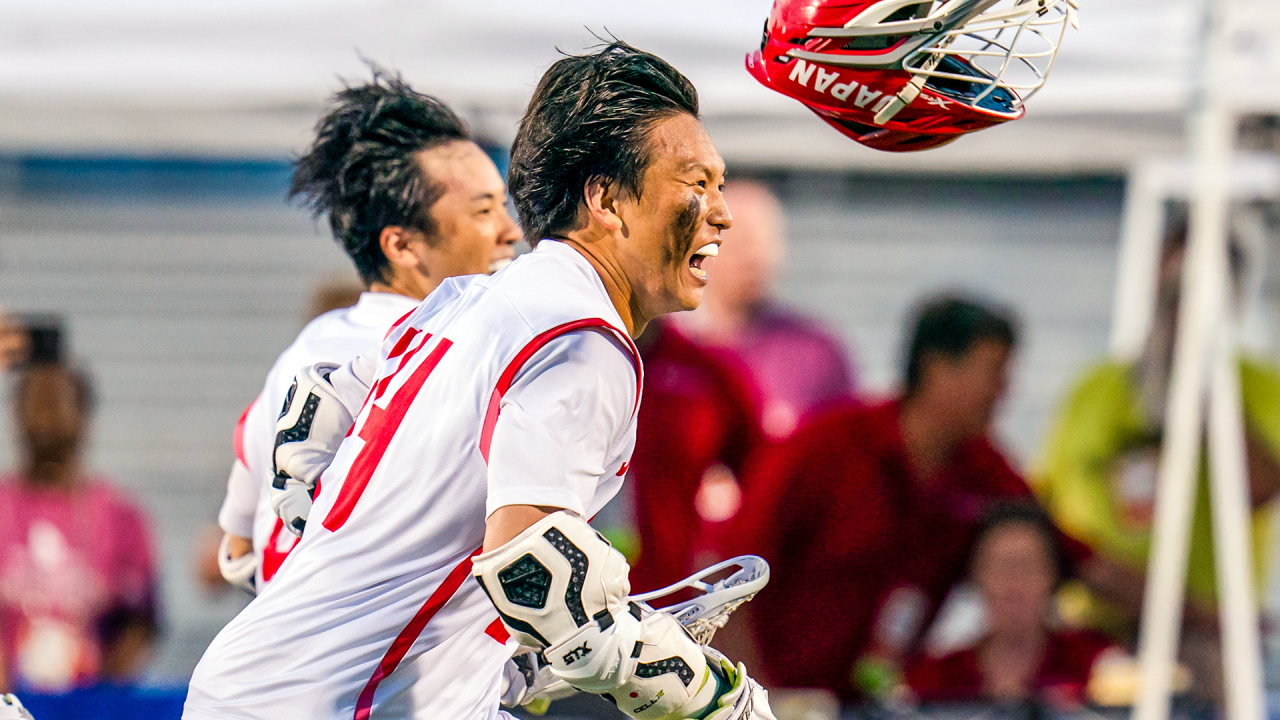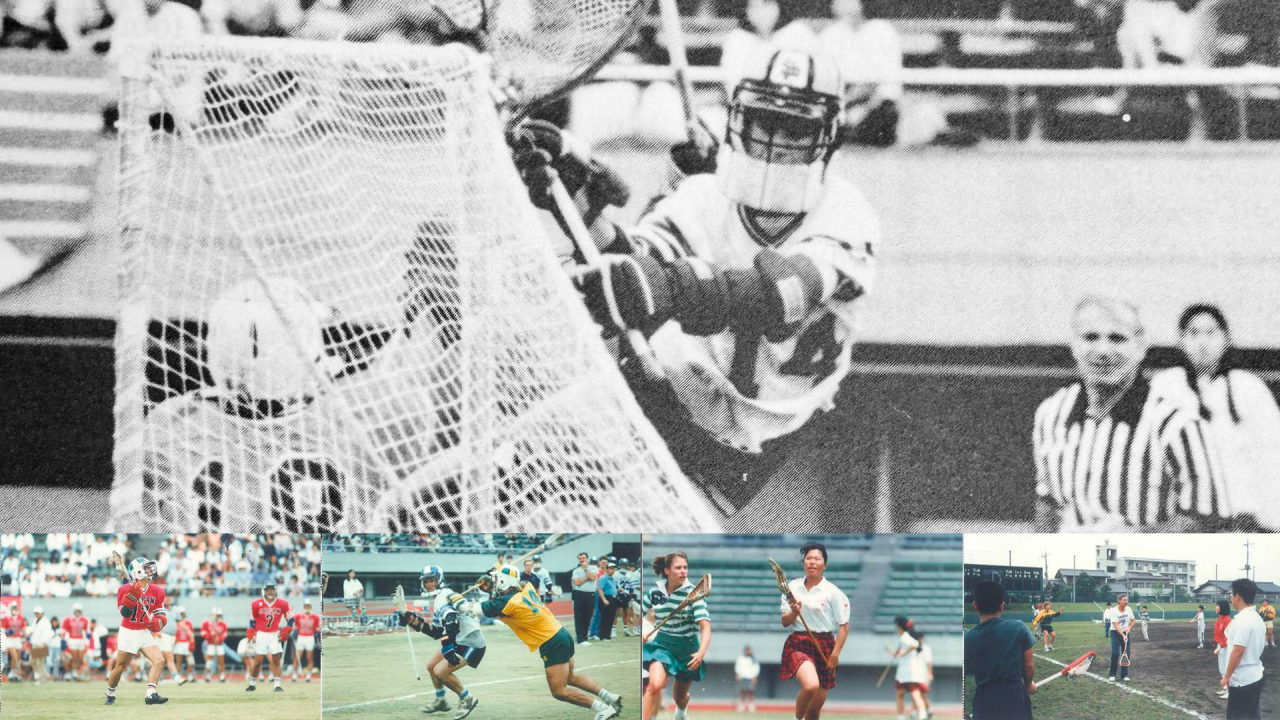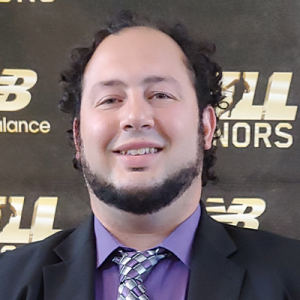
Weekly Cover: Is Japan the Next Global Lacrosse Superpower?
It was a cold and windy March night in Kawasaki, Kanagawa, Japan. The team of Premier Lacrosse League All-Stars had just completed its exhibition game against the Cross Crosse All-Stars, a team of Japanese players. It was so windy that California Redwoods attackman Rob Pannell said it seemed like when clears were thrown, the ball moved backward in the air.
After the game, all he wanted to do was get in the locker room and warm up.
After seeing the reception of the crowd, however, it was hard not to want to linger in the moment.
“Guys went into the locker room to get bags of stuff that they had to throw into the crowd, and the crowd’s going nuts,” he said. “They’re holding up their signs. Guys are holding gloves, getting the crowd to yell and cheer, and I’m sitting there freezing in the wind. I’m looking around. I’m just smiling because you want to get in the locker room and get warm, but you just can’t help but see how special this moment is and how excited the players were to just be there giving stuff to the crowd.”
This was the third time the PLL brought men’s and women’s players overseas for exhibitions in Japan, and it was the latest highlight in the relatively brief but growing timeline of Japanese lacrosse.
Former Johns Hopkins and UMBC head coach Don Zimmerman remembered seeing similar scenes as Pannell described when he went to Japan in the 1980s.
In 1985, Norio Endo — a Johns Hopkins graduate — was working in Tokyo for aerospace company Grumman. He stumbled upon a reception hosted by Hopkins awarding an honorary degree. Endo introduced himself to Ross Jones, the vice president and secretary of the university, and shared that several students from Keio University were interested in lacrosse. Zimmerman recalled the students’ interest in American culture. They wanted to try something not many people were doing.
Endo explained that the way lacrosse is played would allow Japanese players to have success at higher levels.
“The Japanese, because of their size and strength, would never be able to compete with a UCLA or a Notre Dame [in those sports],” Endo, who died in February 2013, said in a Washington Post article published Aug. 22, 1988. “But size has never had much meaning in lacrosse. There is also speed, agility and a hell of a lot of headwork.”
Jones and Johns Hopkins athletic director Bob Scott donated sticks to Keio University. In June 1987, the Japanese Lacrosse Association was formed, and a month later, Zimmerman and four Hopkins players went to Japan and conducted a clinic.
Two years later, Zimmerman and Johns Hopkins were invited along with the Australian national team to Japan to compete in the inaugural International Lacrosse Friendship Games.
“We didn’t know what to expect, you know? We show up the day of the event, and it’s packed,” Zimmerman said earlier this year. “It was like being in a national championship game. Now, there weren’t 35,000 people, but I bet you there were eight to 10,000.
“You arrive the day of the game, and it’s unbelievable. The crowd is there, and the excitement and enthusiasm, you can’t help but shake your head and say, ‘Boy, this is something special.’”
Initial clinics in Japan included the basics, like line drills and appropriate stretching techniques. When Zimmerman returned to Japan with Hall of Famer Jimmy Darcangelo, he was amused to see that everybody learned from Keio University and did the same exact stretches and warmup drills Zimmerman had taught them.
In Zimmerman’s opinion, those eager-to-learn players were a quick study. The group of PLL and Unleashed All-Stars found the same to be true some 30 years later.
Prior to playing exhibition games, the players hosted youth clinics. Pannell said that day stood out most to him on the trip.
“They want to do the next rep and get better in such a short time,” Pannell said. “It’s something that maybe we don’t experience all the time here in the States.”
Rachael DeCecco, the PLL’s vice president of lacrosse who also coached the Unleashed All-Stars, was equally fascinated by the experience.
“There was one little girl, and [Redwoods midfielder] Nakie [Montgomery] was like, ‘She’s gonna be in the pros someday,’” DeCecco said. “By the end of the clinic, she just got it. You’ve been around enough to know when somebody just gets it, and everything clicked for her, and by the end, she was doing so great.”

A CULTURAL PHENOMENON
Kai Iwamoto knows the excitement the young Japanese students went through. He first saw lacrosse as a middle school student in Tokyo. His friends asked him to come to a practice, and he was hooked. He went to a sporting goods store and bought gear later that day.
After playing in the U.S. at UC Irvine, Iwamoto earned a spot on the Denver Outlaws and become the first Japanese-born player in Major League Lacrosse. He’s since founded Manta Ray Lacrosse Club, a youth program in Tokyo.
He’s experienced firsthand the effect the PLL and Unleashed All-Stars have had in his home country.
“[The kids] are always amazed and excited to watch, and [it is] quite motivating for them to play and love lacrosse more,” he said. “One of my kids can’t stop talking about some of the PLL players and told me he watches lots of footage on Instagram.”
Photographs and videos from the Japan exhibitions showed a lot of excitement about the athletes being there. One player the Japanese seemed to love was Maryland Whipsnakes attackman Matt Rambo.
“They love Rambo in Tokyo,” PLL director of brand RJ Kaminski said in one video as fans waved signs with his name and erupted when the former Terp ran by.
Rambo, one of the most charismatic players in the league, was humbled by the fans for showing him so much respect.
“They go crazy,” he said. “It makes you feel great, and that’s something you always dreamed about growing up — of other fans and people that admire what you do. That is a special feeling. You get so much from the USA when you’re in the PLL, but when you get to do it over in another country, it’s extra special.”
The reception the players receive in Japan is genuine; they are incredibly excited to see right in front of them the players they only otherwise see on Instagram or YouTube. Iwamoto called the players “rock stars.” The nation’s love for lacrosse is so strong, there’s even a bar — L’s Base — that is lacrosse-themed and filled with memorabilia.
Does the lacrosse craze sound familiar? It has similar vibes to another major phenomenon in pop culture.
The Beatles made their first trip to the United States in February 1964 greeted by thousands of screaming fans. So many musicians and bands were inspired by the British group.
At the 1992 Summer Olympics, the United States men’s basketball team — nicknamed the “Dream Team” — was the first team allowed to use players from the NBA. The exposure to superstars like Michael Jordan, Charles Barkley and Magic Johnson inspired young basketball players around the globe, and it was a big reason why the NBA saw an influx of talent from Europe, like Hall of Famers Dirk Nowitzki and Pau Gasol.
The 1999 United States women’s soccer team that won the World Cup elevated female athletes on a global stage and helped establish the first professional women’s soccer league while also helping shape the dreams of many young girls.
Lizzie Colson, who stars for Athletes Unlimited and the U.S. Women’s National Team and has traveled to Japan with the Unleashed All-Stars multiple times, said being able to have a similar effect on players in Japan reminds her of her “why.”
“That’s why I started playing. That’s why I love the sport,” she said. “When you’re so close to your ‘why’ like that, it just fuels your fire. You come back to the States with a new appreciation for the growth of the game and the love of the sport.”
With the 2024 Summer Olympics now underway in Paris, the international lacrosse community is eager to fast-forward four years when the sport makes its much-anticipated return to the Games in Los Angeles. They’ll use the sixes discipline, the same version of the sport in which Japan made history two years ago in Alabama.
The effects of the original trips to Japan by Zimmerman and his players have materialized in real ways decades later. It was not lost on the National Lacrosse Hall of Fame coach that the first Friendship Games 35 years ago were played in Tokyo’s Komazawa Olympic Park (home of the 1964 Olympics) and that Japan could be legitimate medal contender in LA28.
The Japan Lacrosse Association has grown from just 21 players in 1986 to nearly 9,000 in 1993 to a peak of nearly 18,000 in 2017. There are now 300 college teams and 100 club teams throughout the country. And they’re producing some outstanding players.
After Iwamoto made his MLL debut, fellow Japanese players Toma Tamura and Kohta Kurashima — both of whom played for the Cross Crosse All-Stars — also earned spots on the Outlaws. Kurashima became the first Japanese player to score in MLL when he scored in a game against the Chesapeake Bayhawks in 2019.
Kokoro Nakazawa became the first Japanese-born player to play lacrosse at a Power 5 school when she debuted for the Louisville women’s team in 2021. As a senior in 2024, the attacker from Yokohama produced career highs in goals (61) and assists (21). Her younger sister, Negai, finished her sophomore season with 24 goals and 11 assists for the Cardinals.
Japan formally announced its place in the future of lacrosse at The World Games in Birmingham, Ala., in 2022. Japan’s men’s team won a bronze medal in sixes by beating Great Britain, marking its first-ever senior-level medal. Japan finished fifth in the U21 men’s championship, women’s championship and senior men’s championship that followed over the course of the next year.
Shinya Tateishi was named to the All-World Team as an attackman at the 2023 World Lacrosse Men’s Championship in San Diego, becoming the first Japanese player to earn the distinction.

EAST ASIA TAKES CENTER STAGE
As the growth of lacrosse in Japan intensifies, the emergence of the sport in East Asia will bring teams from around the world to the region over the next three summers.
Hong Kong, China, will host the upcoming World Lacrosse Women’s U20 Championship in August. Next year, the World Lacrosse Men’s U20 Championship will be in South Korea. Japan will host the 2026 World Lacrosse Women’s Championship and the 2027 World Lacrosse Men’s Championship.
U.S. Women’s U20 National Team head coach Kelly Amonte Hiller played on the senior team that won the gold medal in 1997 — until now the only time a world championship competition has been staged that part of the world. The played in front of packed crowds in Edogawa, Japan.
“Remembering how amazing that experience was and how much the Japanese people celebrated the World Cup, I hope it’s the same in Hong Kong, China,” she said. “It was special to be in a totally different culture and country. We were also housing in the middle of the city like we are in Hong Kong. I’m leaning on that experience and making sure that we do things to get our players feeling that way about this process, as well.”
The all-time leading scorer in U.S. Men’s National Team history, Pannell is positive the world championship experiences will be unforgettable.
“I’m very upset that I’m 34 years old and most likely not going to be experiencing it on Team USA,” he said. “You’re going to get this energy and this excitement around the sport. Stadiums are going to be packed, and it doesn’t matter what country you’re [playing for]. They’re so excited to be around the game and to be learning and to be watching it, and it’s going to be an amazing experience for all involved.”
Colson, who won gold with the U.S. women’s team in 2022, hopes to experience world competition in Japan firsthand.
“They treat us like celebrities. They are so gracious to us,” she said. “I have no doubt that they will treat these other players like stars and how they should be treated. These are the world championships. It’s an elite experience. Japan will do a great job treating it as such.”
While the focus will be on the on-field competition, the connections off the field are just as important. The philosophy of the Japan Lacrosse Association is “Lacrosse Makes Friends.”
Zimmerman has taken that to heart. His Johns Hopkins and UMBC teams have Japanese exchange students manage and practice with the team. He remembers hosting an all-star game that featured an American high school team playing a team from Japan. They took the Japanese players to a Baltimore Orioles game and had a crab feast.
After the 2022 World Lacrosse Women’s Championship in Towson, Md., as a favor to former Johns Hopkins player-manager and now Japan Lacrosse Association president Yusuke Sasaki, Zimmerman and his wife, Dorothy, hosted two players from the Japanese team, Chisa Kobayoski and Maya Taga. What started as a five-day plan blossomed into a five-week stay.
He drove them to Athletes Unlimited games and helped them join club lacrosse teams. He refers to them as their Japanese children.
“To me, it’s all about the personal relationships,” he said. “It has been a privilege working with the Japanese people over the years.”
DeCecco was neighbors in the U.S. Naval Academy dormitories with the Japanese national team when she played in the 2005 world championship. She said the two countries spent a lot of time together and grew friendly despite the language barrier.
She has cherished the opportunity to travel to Japan with the PLL three times. She called herself lucky to go even once and said the trip can change your entire world view.
“We realized how — and this might sound silly — but how big the world is,” she said. “It’s easy to be in our little bubbles and thinking about lacrosse in the United States and within our community. Then you go to Japan, and you realize just how broad the game spreads and how special it is and how it can be a point of connection just like in humanity, like this shared love of something. It’s very eye opening. I leave there every time just so fulfilled and grateful for the opportunity to experience the culture, the people and the game.”
Phil Shore
Phil Shore has covered lacrosse for a variety of publications. He played Division III lacrosse at Emerson College and is the current head coach at Osbourn Park High School in Virginia. His first book, Major League Life, was published in June 2020. Shore has contributed to USA Lacrosse Magazine since 2011.

Categories
Related Articles




